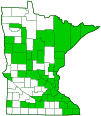Camel crickets
(Ceuthophilus spp.)
Overview • Description • Distribution • Taxonomy
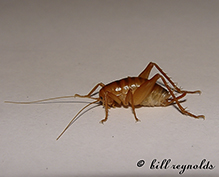
Overview
Ceuthophilus is a genus of large or medium-sized crickets. It occurs in North America from southern Canada to southern Mexico.
There are 87 currently recognized Ceuthophilus species worldwide, all of them in North America north of Mexico, and at least 6 species in Minnesota.
Camel crickets are most commonly found from August to October under rotten logs, stones, mole hills, and other dark, moist places. They are also commonly found in damp basements and crawl spaces.
Adults are active at night. They eat decaying organic matter, including mushrooms, dead insects, fruits, flowers, and dung.
Description
Adult males are ½″ to 1″ long. Females are larger than males.
The head is oval shaped and is bent downward between the forelegs. The antennae are tapered and longer than the body, usually 2 or more times as long as the body.
The body is stout and has a distinctive hump-backed shape. It may be whitish, pale brown, or almost black, with contrasting mottled markings. The egg-laying structure (ovipositor) on females is blade-like and straight.
The legs are long and slender. The fourth segment of the leg (tibia) is longer than the third segment (femur). The tibia of each back leg is thick and has more than four pairs of movable spines. There is no spine on the front or side (dorso-lateral) surface of the tibia of the front leg. All legs have four end segments (tarsi). The first tarsal segment is almost as long as the remaining segments together.
There are no wings or hearing organs (tympani).
Distribution |
||
|
Sources Biodiversity occurrence data published by: Minnesota Biodiversity Atlas (accessed through the Minnesota Biodiversity Atlas Portal, bellatlas.umn.edu, 10/20/2025). Hebard, Morgan. (1932). The Orthoptera of Minnesota. University of Minnesota. Minnesota Agricultural Experiment Station. Retrieved from the University of Minnesota Digital Conservancy, https://hdl.handle.net/11299/204015. |
|
| 10/20/2025 | ||
Taxonomy
Order
Orthoptera (grasshoppers, crickets, and katydids)
Suborder
Ensifera (katydids, crickets, and allies)
Infraorder
Tettigoniidea (katydids, wēta, and allies)
Superfamily
Rhaphidophoroidea (camel crickets, cave crickets, and cave wētas)
Family
Rhaphidophoridae (camel crickets, cave crickets, and cave wēta)
Subfamily
Ceuthophilinae
Tribe
Ceuthophilini
Subordinate Taxa
Subgenus Ceuthophilus
Agassiz’s camel cricket (Ceuthophilus agassizii) ![]()
Arizona camel cricket (Ceuthophilus arizonensis) ![]()
black-sided camel cricket (Ceuthophilus latens) ![]()
![]()
boreal camel cricket (Ceuthophilus brevipes) ![]()
camel cricket (Ceuthophilus conicaudus) ![]()
camel cricket (Ceuthophilus variegatus) ![]()
Chiricahua cave cricket (Ceuthophilus chiricahuae) ![]()
divergent camel cricket (Ceuthophilus divergens) ![]()
![]()
Huachuca camel cricket (Ceuthophilus paucispinosus) ![]()
Kentucky cave cricket (Ceuthophilus stygius) ![]()
Mississippi camel cricket (Ceuthophilus mississippi ) ![]()
Ozark cave cricket (Ceuthophilus williamsoni) ![]()
pale camel cricket (Ceuthophilus pallescens) ![]()
pale-legged camel cricket (Ceuthophilus pallidipes) ![]()
plains camel cricket (Ceuthophilus pallidus) ![]()
![]()
secluded camel cricket (Ceuthophilus seclusus) ![]()
slender-legged camel cricket (Ceuthophilus gracilipes) ![]()
spotted camel cricket (Ceuthophilus maculatus) ![]()
![]()
striped camel cricket (Ceuthophilus meridionalis) ![]()
Texas cave cricket (Ceuthophilus secretus) ![]()
Uhler’s camel cricket (Ceuthophilus uhleri) ![]()
Utah camel cricket (Ceuthophilus utahensis) ![]()
Yavapai camel cricket (Ceuthophilus yavapai) ![]()
Subgenus Geotettix
alpine camel cricket (Ceuthophilus alpinus) ![]()
camel cricket (Ceuthophilus caudelli) ![]()
camel cricket (Ceuthophilus hebardi) ![]()
camel cricket (Ceuthophilus inyo) ![]()
camel cricket (Ceuthophilus nodulosus) ![]()
fusiform camel cricket (Ceuthophilus fusiformis) ![]()
![]()
Thomas’ camel cricket (Ceuthophilus guttulosus) ![]()
woodland camel cricket (Ceuthophilus silvestris) ![]()
![]()
Subgenus Hemiudeopsylla
California camel cricket (Ceuthophilus californianus) ![]()
camel cricket (Ceuthophilus fossor) ![]()
camel cricket (Ceuthophilus lamellipes) ![]()
San Diego camel cricket (Ceuthophilus hesperus) ![]()
Synonyms
Ceutophilus
Onthophilus
Common Names
camel crickets
Glossary
Femur
On insects and arachnids, the third, largest, most robust segment of the leg, coming immediately before the tibia. On humans, the thigh bone.
Ovipositor
A tube-like organ near the end of the abdomen of many female insects, used to prepare a place for an egg and to place the egg.
Tarsus
The last two to five sections of an insect’s leg, attached to the tibia; the foot. Plural: tarsi.
Tibia
The fourth segment of an insect leg, after the femur and before the tarsus (foot). The fifth segment of a spider leg or palp. Plural: tibiae.
Tympanum
An external hearing structure. In reptiles and amphibians, the circular, disk-like membrane that covers the ear opening. In insects, the membrane covering the air sac and sensory neurons. Plural: tympani.
Visitor Photos
Share your photo of this insect.
This button not working for you?
Simply email us at info@MinnesotaSeasons.com.
Attach one or more photos and, if you like, a caption.
Brandi |
 |
Troy Bauer |
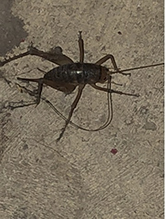 |
I came across your page while looking for information to identify a strange looking critter. I am 49 years old and still in the same small rural farming community I grew up in. I have never seen one of these weird little critters. It is a camel cricket or spider cricket. I see on your distributing map that my area does not show them. I am in Kenyon, MN and it is confirmed that they are certainly here now. Great site. Keep up the good work. |
Jason and Amanda Alexander |
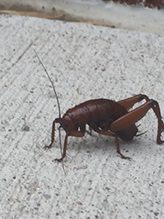 |
Bill Reynolds |
||
While trapping pocket gophers in my garden, this little fella hopped out. |
||
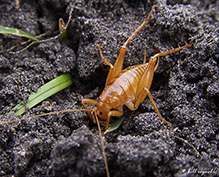 |
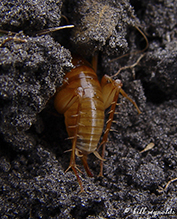 |
|
 |
||
MinnesotaSeasons.com Photos
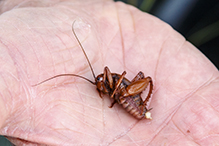 |

Slideshows

Visitor Videos
Share your video of this insect.
This button not working for you?
Simply email us at info@MinnesotaSeasons.com.
Attach a video, a YouTube link, or a cloud storage link.
Other Videos
Cave Cricket (Camel cricket) Ceuthophilus sp.
The Wimberley Naturalist
Camel Cricket (Rhaphidophoridae: Ceuthophilus) Dorsal view
Carl Barrentine

Visitor Sightings
Report a sighting of this insect.
This button not working for you?
Simply email us at info@MinnesotaSeasons.com.
Be sure to include a location.
Steven Conn
10/20/2025
Location: St. James, MN
Margo Bremer
6/21/2019
Location: Zumbrota, MN
We live in the country, close to the Zumbro River. I have seen camel crickets in our basement once or twice a year over the last few years, and being a nature lover, I capture them and set them free outside. This last one I discovered in our basement shower.
Troy Bauer
8/12/2018

Location: Kenyon, MN
I came across your page while looking for information to identify a strange looking critter. I am 49 years old and still in the same small rural farming community I grew up in. I have never seen one of these weird little critters. It is a camel cricket or spider cricket. I see on your distributing map that my area does not show them. I am in Kenyon, MN and it is confirmed that they are certainly here now. Great site. Keep up the good work.
MinnesotaSeasons.com Sightings

